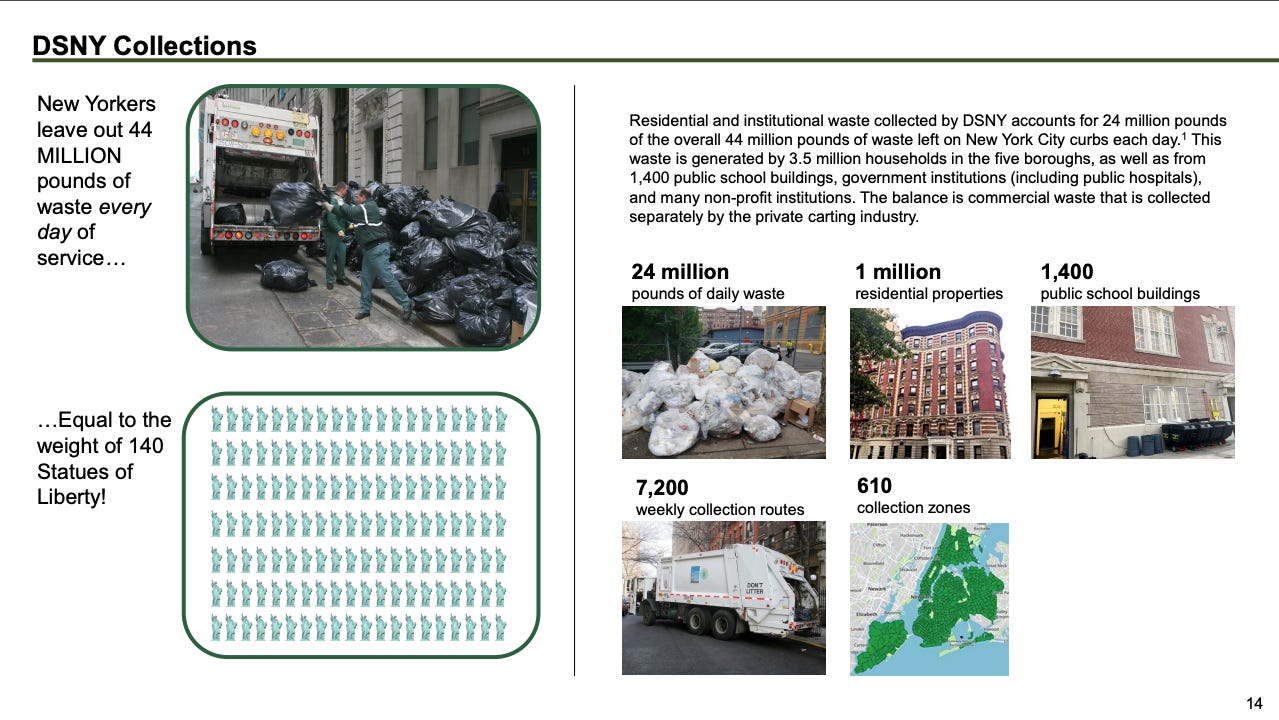New York's Trash Revolution
And the rise of *🤖~containerization~🤖*
If there’s one thing we know about Mayor Eric Adams, it’s that he hates rats.
The mayor famously hired a Rat Czar to help him wage war on rats, but apparently isn’t satisfied with current progress and has brought in outside help.
Enter McKinsey & Company, a firm which produces and sells slide decks.
The city paid McKinsey millions of dollars to work with the Department of Sanitation (whose mascots are a Rat Report fan favorite) to conduct a study on trash and its impact on cleanliness and rats.
The resulting deck, available here, features 95 official-looking slides replete with maps and graphs, and concludes that placing trash in bins is indeed a better idea than throwing trash on the ground.
It also addresses the challenges of containerization.
The discerning reader, like anyone else in the world, may be asking what the fuck “containerization” means.
Containerization is defined in the deck as “the storage of waste in sealed, rodent-proof receptacles.”
It’s a scientific-sounding way to say “put trash in bins,” but with more syllables.
“Hmm, containerization, huh? That’s good, write that down! That’s worth a million dollars right there!” said a McKinsey partner during a brainstorming session, probably.
The findings of the study spurred the mayor to hold a press conference where he blasted Empire State of Mind before gleefully dunking a prop trash bag into New York City’s first official trash bin, complete with latching lid to deter hungry rodents.
“Welcome,” said the mayor, “to our trash revolution.”
Mayor Adams stated that garbage bags on the sidewalk cause “just, really, total visual despair” and that the rats are “getting more and more bold, they no longer run from you, they just hang out and just do what they want.”
Terrified by the prospect of rats just hanging out and doing what they want, I reviewed the slide deck to learn how Mayor Adams and McKinsey plan to lead us to a containerized future.
Below are a few slides from the deck.
Slide 11 addresses the burning question on everyone’s mind: why does containerization matter?
The answer is threefold:
Rats
Pedestrian obstruction
I can’t tell whether an intern doodled on this next slide in Microsoft Paint, or if the cube (the largest cubic foot ever drawn) and outline of Manhattan are important visual aids.
I decided to pick up where the intern left off and supplied additional doodles.

This slide converts the weight of trash produced daily in NYC to 140 Statues of Liberty. I imagine McKinsey’s interaction with the Department of Sanitation went something like this:
McKinsey: “New Yorkers leave out 44 MILLION pounds of waste every day!
Department of Sanitation: *shrug shoulders, look confused*
McKinsey: “That’s equal to the weight of 140 Statues of Liberty!”
Department of Sanitation: “Ahh, why didn’t you just say so? We know exactly how much that weighs now.”
A little-known fact is that New Yorkers actually measure things exclusively in units of Statues of Liberty.
My New York driver’s license lists my height and weight as 0.01976 and 0.00054 Statues of Liberty, respectively.
Real New Yorkers also know that the Statue of Liberty isn’t even that big; if anything, this stat makes me less impressed with the amount of trash we produce.
I also enjoyed this map of “collection zones.”
Did they need a map?
Could they have just said that everything is a collection zone except Central Park and the beach?
The deck is a lengthy read so I skimmed most of it, but I took solace in the fact that the greatest minds of our generation have figured out how New Yorkers could start putting trash in bins, and I’m excited to see what the future holds.







This can change the world!
😅😅😅